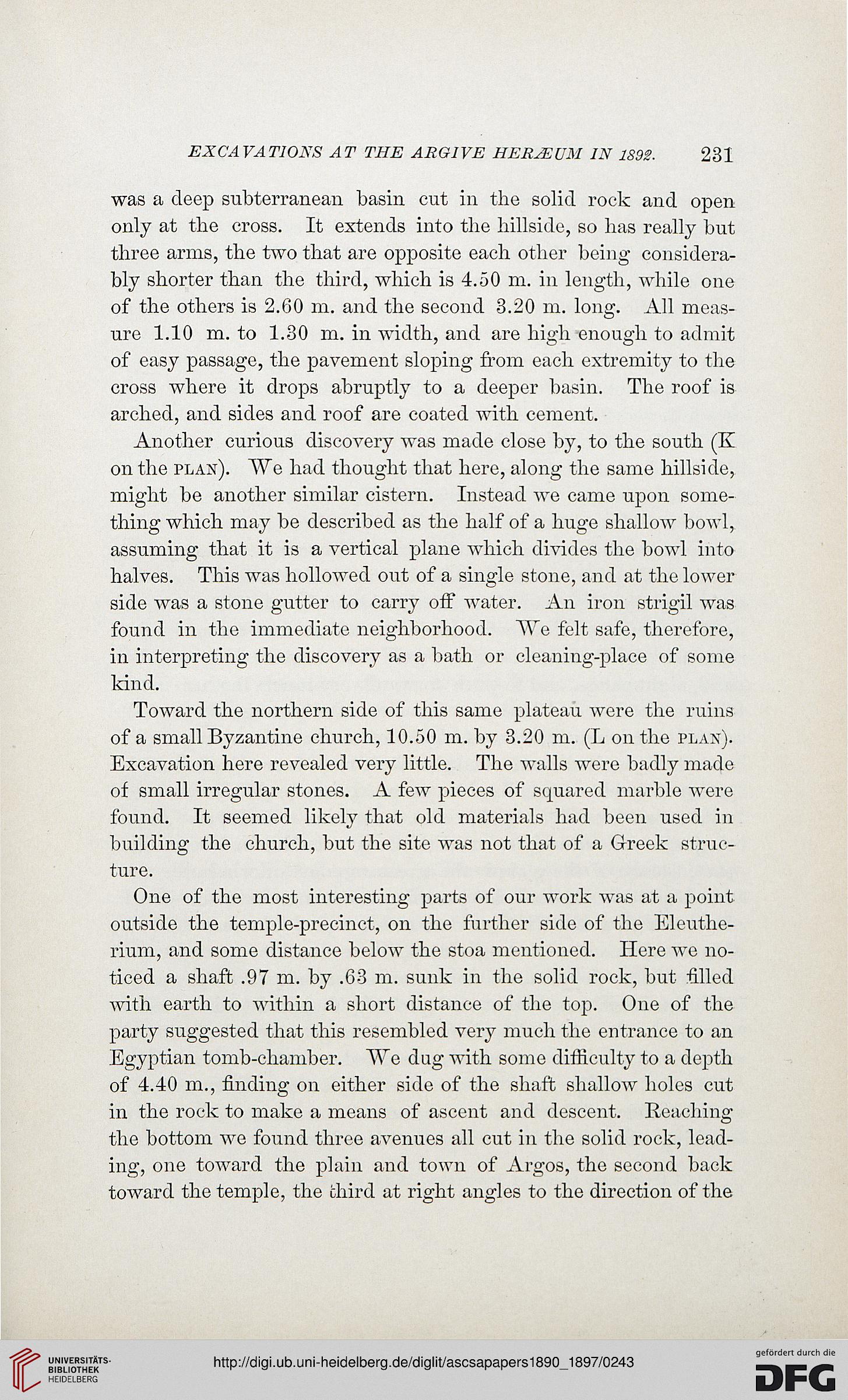EXCAVATIONS AT THE ARG1VE HERJEUM IN 1892. 231
was a deep subterranean basin cut in the solid rock and open
only at the cross. It extends into the hillside, so has really but
three arms, the two that are opposite each other being considera-
bly shorter than the third, which is 4.50 m. in length, while one
of the others is 2.60 m. and the second 3.20 m. long. All meas-
ure 1.10 m. to 1.30 m. in width, and are high enough to admit
of easy passage, the pavement sloping from each extremity to the
cross where it drops abruptly to a deeper basin. The roof is
arched, and sides and roof are coated with cement.
Another curious discovery was made close by, to the south (K
on the plan). We had thought that here, along the same hillside,
might be another similar cistern. Instead we came upon some-
thing which may be described as the half of a huge shallow bowl,
assuming that it is a vertical plane which divides the bowl into
halves. This was hollowed out of a single stone, and at the lower
side was a stone gutter to carry off water. An iron strigil was
found in the immediate neighborhood. We felt safe, therefore,
in interpreting the discovery as a bath or cleaning-place of some
kind.
Toward the northern side of this same plateau were the ruins
of a small Byzantine church, 10.50 m. by 3.20 m. (L on the plan).
Excavation here revealed very little. The walls were badly made
of small irregular stones. A few pieces of scmared marble were
found. It seemed likely that old materials had been used in
building the church, but the site was not that of a Greek struc-
ture.
One of the most interesting parts of our work was at a point
outside the temple-precinct, on the further side of the Eleuthe-
rium, and some distance below the stoa mentioned. Here we no-
ticed a shaft .97 m. by .63 m. sunk in the solid rock, but filled
with earth to within a short distance of the top. One of the
party suggested that this resembled very much the entrance to an
Egyptian tomb-chamber. We dug with some difficulty to a depth
of 4.40 in., finding on either side of the shaft shallow holes cut
in the rock to make a means of ascent and descent. Reaching
the bottom we found three avenues all cut in the solid rock, lead-
ing, one toward the plain and town of Argos, the second back
toward the temple, the third at right angles to the direction of the
was a deep subterranean basin cut in the solid rock and open
only at the cross. It extends into the hillside, so has really but
three arms, the two that are opposite each other being considera-
bly shorter than the third, which is 4.50 m. in length, while one
of the others is 2.60 m. and the second 3.20 m. long. All meas-
ure 1.10 m. to 1.30 m. in width, and are high enough to admit
of easy passage, the pavement sloping from each extremity to the
cross where it drops abruptly to a deeper basin. The roof is
arched, and sides and roof are coated with cement.
Another curious discovery was made close by, to the south (K
on the plan). We had thought that here, along the same hillside,
might be another similar cistern. Instead we came upon some-
thing which may be described as the half of a huge shallow bowl,
assuming that it is a vertical plane which divides the bowl into
halves. This was hollowed out of a single stone, and at the lower
side was a stone gutter to carry off water. An iron strigil was
found in the immediate neighborhood. We felt safe, therefore,
in interpreting the discovery as a bath or cleaning-place of some
kind.
Toward the northern side of this same plateau were the ruins
of a small Byzantine church, 10.50 m. by 3.20 m. (L on the plan).
Excavation here revealed very little. The walls were badly made
of small irregular stones. A few pieces of scmared marble were
found. It seemed likely that old materials had been used in
building the church, but the site was not that of a Greek struc-
ture.
One of the most interesting parts of our work was at a point
outside the temple-precinct, on the further side of the Eleuthe-
rium, and some distance below the stoa mentioned. Here we no-
ticed a shaft .97 m. by .63 m. sunk in the solid rock, but filled
with earth to within a short distance of the top. One of the
party suggested that this resembled very much the entrance to an
Egyptian tomb-chamber. We dug with some difficulty to a depth
of 4.40 in., finding on either side of the shaft shallow holes cut
in the rock to make a means of ascent and descent. Reaching
the bottom we found three avenues all cut in the solid rock, lead-
ing, one toward the plain and town of Argos, the second back
toward the temple, the third at right angles to the direction of the





